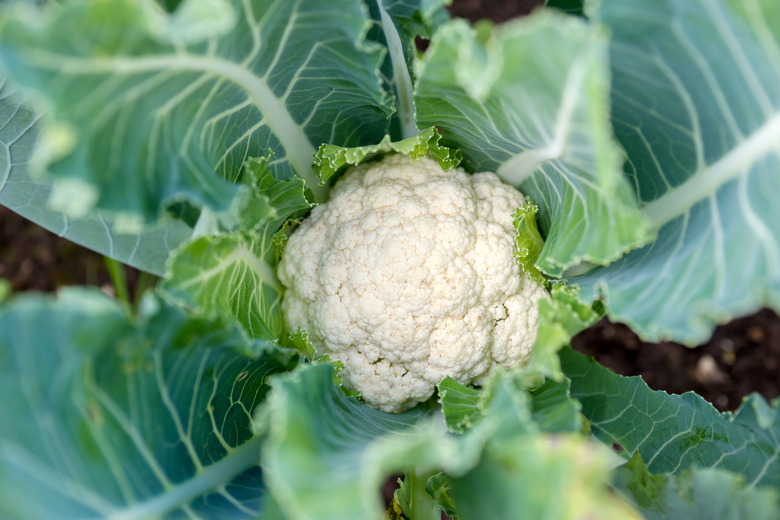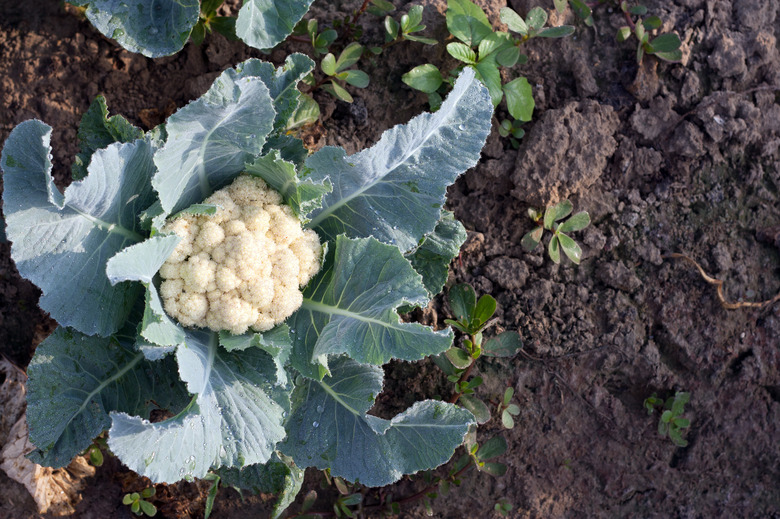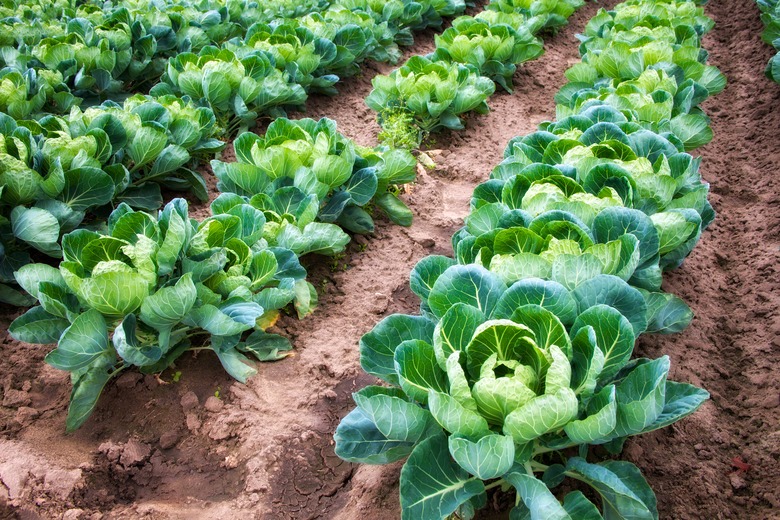How To Grow Cauliflower
We may receive a commission on purchases made from links.
- Best uses for cauliflower
- How to grow cauliflower
- In what zone does cauliflower grow best?
- When should you plant cauliflower?
- Soil, sunlight and water recommendations for cauliflower
- How to propagate cauliflower
- How to harvest cauliflower
- Common pests and other problems for cauliflower
- Common diseases for cauliflower
Mark Twain once quipped that a cauliflower (Brassica oleracea [Botrytis Group]) is nothing but a cabbage with a college education, and if that were true, it might help to explain why it's such a finicky plant to grow. Perhaps it spends too much time reading books and too little time adapting to changing conditions, unlike related cole crops like broccoli (B. oleracea, [Italica Group), kale (B. oleracea [Acephala Group]), Brussels sprouts (B. oleracea [Gemmifera Group]) and, of course, the undereducated cabbage (B. oleracea [Capitata Group]). Whatever the reason, growing cauliflower in your vegetable garden will challenge your gardening skills, but if you are successful, you'll be rewarded with delicious and versatile fare for the dining room table.
In the gluten-free and low-carb age, chefs have found all sorts of ways to substitute cauliflower for glutinous ingredients and expand its use beyond the familiar. It can be tuned into bread, shredded into a rice alternative, formed into pasta and mashed like potatoes. When steamed or baked and served with cheese or a creamy sauce, it's a popular side dish without any modifications at all, and it's also a delicious raw snack for dipping into ranch dressing.
The plant that provides all this culinary adaptability is one with large, thick, dark-green, edible leaves that spread as far as 24 inches in all directions to frame a dense head of meaty buds, which will turn into flowers if the biennial plant isn't harvested in its first season. The buds, which are known as curds, aren't always white; there are colored varieties that are yellow, orange or even purple, although purple coloration on a white species is a sign of distress. Cauliflower is a cool-weather plant with a growing season from 55 to 100 days, and it doesn't tolerate heat or drought, so it's best grown in moist soil during the spring or fall in most places.
Best Uses for Cauliflower
Best Uses for Cauliflower
Cauliflower is a veggie and doesn't have much use as a decorative plant, especially since it requires growing conditions that other plants don't. The cauliflower plant grows so large and has such specific nutrient requirements that many gardeners recommend growing it on its own in a separate patch of the vegetable garden. Its traditional companion plants are beans, peas, spinach and celery, and legumes like peas and beans are preferred because they help fix nitrogen in the soil, and cauliflower needs a lot of nitrogen. Certain herbs, such as dill, chamomile and sage, can also benefit cauliflower when grown nearby.
Not all gardeners are in agreement about the usefulness of companion planting when it comes to cauliflower. If you're a novice and the garden is large enough, it's best to give cauliflower its own territory. Once you're familiar with its nutritional needs and responsiveness to your climate zone, you can experiment with companion planting.
How to Grow Cauliflower
How to Grow Cauliflower
- Common Name: Cauliflower
- Botanical Name: Brassica oleracea (Botrytis Group)
- When to Plant: Early spring or mid to late summer depending on variety
- USDA Zones: Grown as an annual in zones 2-11
- Sun Exposure: Full sun, limited shade
- Soil Type: Rich, well-draining, moist soil. Fertilizer is usually needed.
- When it's in Trouble: Head turns brown and leaves develop holes or shrivel, indicating soil problems or insect activity. Flowers may form prematurely in warm weather.
- When it's Thriving: Leaves are lush, green and tender, and the head is dense and well-packed.
Starting Cauliflower From Seed
It's easier to grow cauliflower from nursery starts than from seed, but if you do sow cauliflower seeds and you want a summer harvest, the best time to do it is four to five weeks before the last spring frost. You want the seedlings to be ready to go in the ground two to three weeks before the last frost so the plant can mature before temperatures reach a consistent 75 degrees, which can cause the flower to bolt, or flower prematurely. If you plant a fall season crop, start seeds eight to 12 weeks before the first autumn frost so they'll be ready to transplant when the cool weather arrives.
Space the seeds 3 to 6 inches apart and cover them with 1/4 to 1/2 inch of dirt. Keep the ground consistently moist during germination and growth. Keep the temperature a consistent 60 degrees but do not use bottom heat. When the first two true leaves appear, turn on the grow lights and apply fertilizer twice a week. Just before transplanting the seedlings, after four or five true leaves have appeared, harden them off by moving them outside and gradually exposing them to more and more sunlight over a period of five days to a week.
Starting Cauliflower From a Seedling
When transplanting seedlings, space them 2 feet apart in rows that are 30 inches apart to prevent the plants from crowding each other, which can promote fungal growth. Because the transplants have to be in the ground before the last frost, it's a good idea to cover them with old milk jugs to protect them from freezing temperatures, which could stunt their growth or ruin the head by promoting buttoning, which occurs when the head, which should be tightly packed, separates.
Prepare the soil by adjusting the pH as needed to bring it to somewhere between 6.0 and 7.0, working the soil to a depth of 6 inches and adding a 5-10-10 fertilizer. Keep the ground around the seedlings moist, adding mulch around the base of each one to retain moisture and control weed growth.
In What Zone Does Cauliflower Grow Best?
In What Zone Does Cauliflower Grow Best?
Cauliflower grows as an annual in USDA hardiness zones 2 through 11, which encompasses most of the United States and Canada, but cauliflower plants prefer cool temperatures, so they do better in the North provided that the growing season is frost-free for at least 60 days. Temperatures shouldn't rise much above 75 degrees because that can cause buttoning, or misshapen heads. You can usually mitigate higher temperatures by shading the plants with floating row covers to protect them from intense sunlight.
When Should You Plant Cauliflower?
When Should You Plant Cauliflower?
Cauliflower doesn't like extreme heat or cold, so the best time to plant it is in the early spring, about two to three weeks before the last spring frost, or late summer, about six to eight weeks before the first fall frost. Temperatures should be consistently below 75 degrees to ensure the cauliflower plants have the cool, sunny weather they need. In most regions, you can grow two crops a year, planting the fall crop soon after harvesting the spring one. Remember that seeds take about two weeks to germinate and sprout, so add that time to the schedule if you're starting from seed.
Soil, Sunlight and Water Recommendations for Cauliflower
Soil, Sunlight and Water Recommendations for Cauliflower
To grow cauliflower successfully in your home garden, you need moist soil with plenty of nutrients. You can often supply needed nutrients by working well-rotted manure or compost into the soil, but if a soil test shows a deficiency of nitrogen, phosphorus or potassium, you should add an appropriate fertilizer when transplanting and as a side dressing while the plants are growing.
The ideal soil pH is between 6.0 and 7.0. If the soil test indicates acidic soil, it's important to work in some lime to raise the pH in order to prevent clubroot, a fungal disease that stunts the growth of the plant by attacking the roots.
Cauliflower needs full sun, although on hot days, shading with row covers is recommended. The soil must be kept moist but not wet. Water regularly and mulch around each plant to retain moisture in the soil.
How to Propagate Cauliflower
How to Propagate Cauliflower
Cauliflower is a biennial, which means it will flower and produce seeds in its second year. If you want to collect the seeds, cover the plants during the winter to protect them from freezing. Cauliflower roots are sensitive and don't like to be moved, so transplanting from the ground into containers isn't an option, but if you grow a plant in a large, movable container for the purpose of seed collection, you can move the container indoors and put it under grow lights for the winter. It's important to note, however, that hybrid plants may not produce viable seeds or plants that come true to the parent plant. Grow an heirloom variety if you want to save the seeds.
How to Harvest Cauliflower
How to Harvest Cauliflower
Before harvest, white cauliflower needs blanching, or the sun will turn it yellow. You do this by wrapping the outer leaves around the head when it's about the size of an egg and tying the leaves with twine or a rubber band. This isn't necessary with colored cauliflowers, such as purple or orange cultivars. You can also plant self-blanching cauliflower, which has leaves that automatically grow around the head to protect it.
Harvest the head about seven to 12 days after blanching while it is still tight and compact and has grown to about 6 to 8 inches in diameter. Cut the head at ground level, leaving at least one set of leaves attached to protect it. Cauliflower will keep in a refrigerator for about a week.
Common Pests and Other Problems for Cauliflower
Common Pests and Other Problems for Cauliflower
Cauliflower is susceptible to all the pests that attack other crops in the cabbage family, including cabbage worms, flea beetles and the cabbage lopper. These pests eat holes in the leaves and can be controlled either by physical removal or a treatment with organic Bacillus thuringiensis, which won't harm beneficial insects like ladybugs.
Cabbage maggots are also a common pest that feeds on the roots, causing the cauliflower heads to turn brown, the leaves to wilt and the plant to die. They hatch from eggs deposited by the cabbage root fly, and to discourage the worms from digging into the soil, it sometimes helps to spread diatomaceous earth around each plant. You can also try planting a sacrificial crop of collards around the cauliflower plants to attract these and other pests.
Aphids are small crawling insects that colonize the undersides of leaves and deposit a sticky substance known as honeydew that promotes the growth of sooty mold. You can usually dislodge them by spraying the leaves with a jet of water.
Common Diseases for Cauliflower
Common Diseases for Cauliflower
Clubroot is a fungus that thrives in acidic soil, and when it affects cauliflower plants, it usually means the soil pH is too low. It deforms the roots and stunts the growth of the plant, and once you discover it, the only solution is to uproot the plant. The pathogen lives in the soil, so don't plant cauliflower in that location the following season.
Downy mildew is a fungus with the ability to destroy a young cauliflower plant. It's recognizable by a fluffy yellowish deposit on the undersides of the leaves that eventually turns brown. You can treat it with an organic fungicide.
Other fungal diseases such as black rot, powdery mildew, Sclerotinia white mold (stem rot) and Verticillium wilt cause varying degrees of damage to leaves, florets or the entire plant. You may have success by treating the affected plants with a fungicide, but because the pathogens live in the soil, the only surefire control strategy is to dig up the affected plants and avoid planting cauliflower in that location for the next three years.
References
- GardenZeus: Advanced Tip: Cauliflower and Companion Planting
- Missouri Botanical Garden: Brassica oleracea (Botrytis Group)
- The Old Farmer's Almanac: Growing Cauliflower
- University of Minnesota Extension: Growing Cauliflower in Home Gardens
- Gardener's Path: How to Grow Cauliflower, a Challenging Cool-Weather Crop
- Seminis: Managing Cauliflower Diseases


